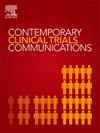Approach Bias Modification for reducing Co-Occurring Alcohol and cannabis use among treatment-seeking Adolescents: Protocol of a randomized controlled trial
IF 1.4
Q4 MEDICINE, RESEARCH & EXPERIMENTAL
引用次数: 0
Abstract
Alcohol and cannabis are the first and second most used substances among adolescents. Adolescence is a period of considerable development, making the adolescent brain particularly vulnerable to negative effects of alcohol and cannabis use. Developing and testing interventions that target both alcohol and cannabis use during adolescence are vital to decreasing costly consequences. Biases in cognitive processing of drug-related stimuli play an important role in the development and maintenance of problematic substance use. The Approach-Avoidance Task (AAT) is a computerized program, effective in assessing implicit approach biases for both alcohol and cannabis, in which participants make approach or avoidance movements in response to an irrelevant feature of an image presented on a screen (e.g., push when in portrait, pull when in landscape). A modified version of the AAT is also used as an approach bias modification (ApBM) intervention, to retrain participants’ implicit biases toward or away from stimuli by presenting the target stimuli predominantly in one format (e.g., push or pull). Despite research demonstrating the effectiveness of AAT interventions to reduce problematic alcohol and cannabis use, there is a dearth of research examining this intervention among adolescents. This protocol paper describes a NIDA-funded randomized control trial (RCT) to evaluate an integrated mobile ApBM intervention to target co-occurring alcohol and cannabis use among treatment-seeking adolescents. Outcomes will be measured from pre-treatment through a three-month follow-up. The sampling procedures, assessment protocol, description of the intervention, and planned statistical approaches to evaluating outcomes are detailed. Clinical and research implications of this work are also discussed.
求助全文
约1分钟内获得全文
求助全文
来源期刊

Contemporary Clinical Trials Communications
Pharmacology, Toxicology and Pharmaceutics-Pharmacology
CiteScore
2.70
自引率
6.70%
发文量
146
审稿时长
20 weeks
期刊介绍:
Contemporary Clinical Trials Communications is an international peer reviewed open access journal that publishes articles pertaining to all aspects of clinical trials, including, but not limited to, design, conduct, analysis, regulation and ethics. Manuscripts submitted should appeal to a readership drawn from a wide range of disciplines including medicine, life science, pharmaceutical science, biostatistics, epidemiology, computer science, management science, behavioral science, and bioethics. Contemporary Clinical Trials Communications is unique in that it is outside the confines of disease specifications, and it strives to increase the transparency of medical research and reduce publication bias by publishing scientifically valid original research findings irrespective of their perceived importance, significance or impact. Both randomized and non-randomized trials are within the scope of the Journal. Some common topics include trial design rationale and methods, operational methodologies and challenges, and positive and negative trial results. In addition to original research, the Journal also welcomes other types of communications including, but are not limited to, methodology reviews, perspectives and discussions. Through timely dissemination of advances in clinical trials, the goal of Contemporary Clinical Trials Communications is to serve as a platform to enhance the communication and collaboration within the global clinical trials community that ultimately advances this field of research for the benefit of patients.
 求助内容:
求助内容: 应助结果提醒方式:
应助结果提醒方式:


